My Boss Told Me to Fudge the Numbers — I Let Her Dig Her Own Grave

In this corporate cautionary tale, the poster works in a mid-sized company handling internal reports—a position that demands both accuracy and integrity. Recently, their boss, under pressure to meet departmental expectations, subtly encouraged them to manipulate figures to cast their team in a more favorable light. Rather than overtly ordering a lie, she used coded language, hoping the employee would “adjust” numbers to meet previous promises. Recognizing the ethical red flags, the poster chose not to comply with the veiled directive. Instead, they meticulously documented everything: the raw data, final report, and all related communication, ensuring transparency and accountability.
When leadership questioned discrepancies between the real report and what their boss had promised, she attempted to deflect blame. But thanks to the thorough digital trail, it quickly became clear where the dishonesty originated. HR intervened, and the boss was forced to resign under the guise of a voluntary exit. The poster never raised their voice or exposed their boss aggressively—they simply let the truth surface on its own. It’s a powerful example of how integrity and quiet resistance can protect both careers and corporate ethics in a high-pressure workplace.
Advertisement – Continue Reading Below
Bosses are typically responsible for making sure that all of their workers follow the rules

Advertisement – Continue Reading Below
So when this employee was asked by their boss to falsify reports, they immediately knew that would be a bad idea
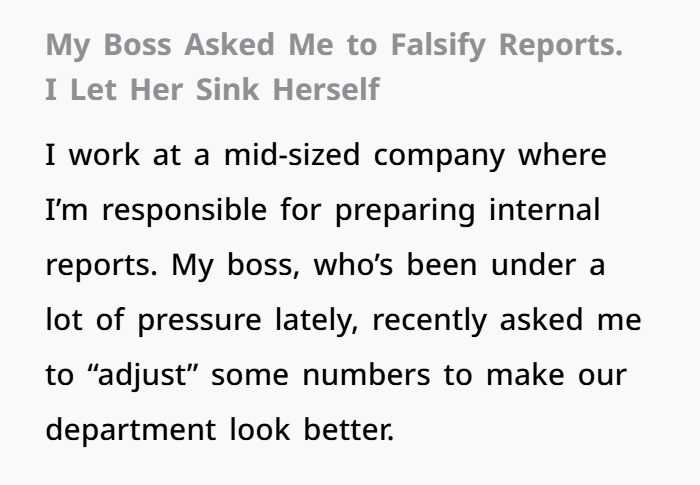
Advertisement – Continue Reading Below
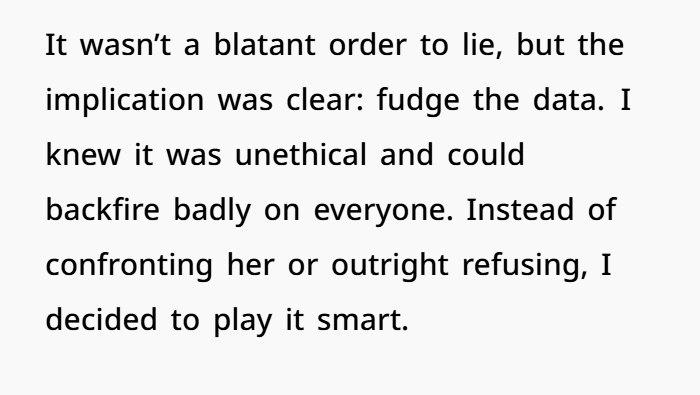
Advertisement – Continue Reading Below
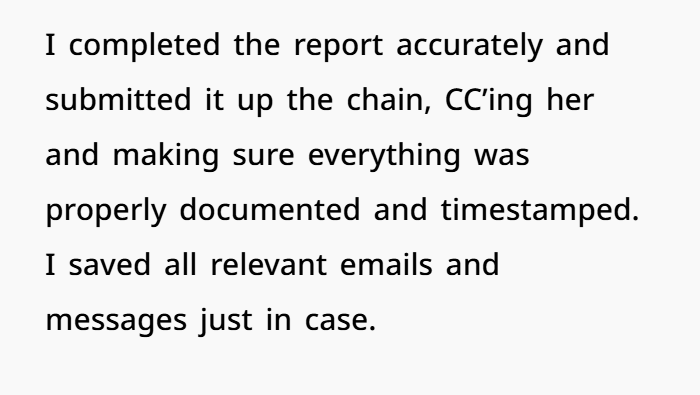
Advertisement – Continue Reading Below
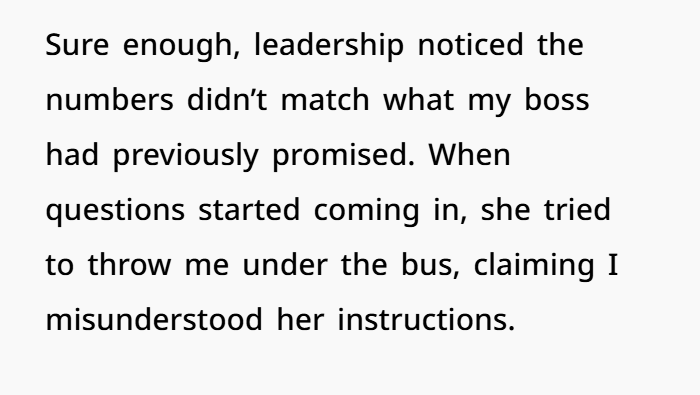
Advertisement – Continue Reading Below
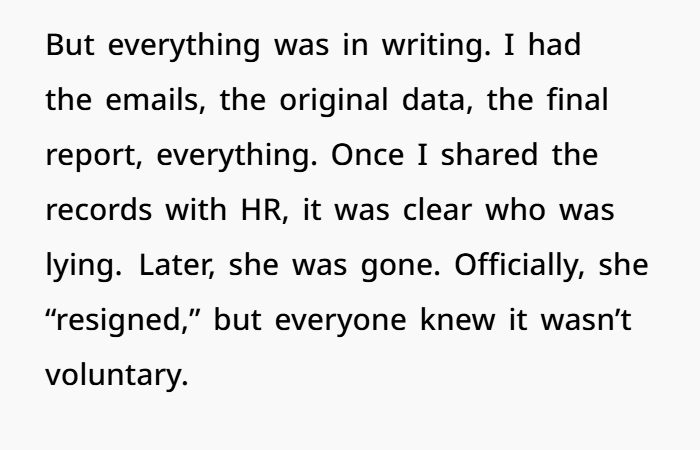
Advertisement – Continue Reading Below
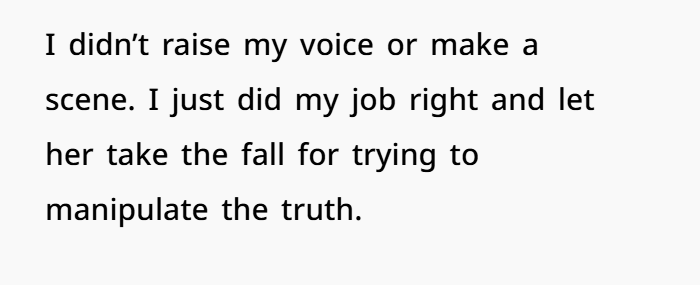
Advertisement – Continue Reading Below
Falsifying business records, even in seemingly minor internal reports, is a serious ethical and legal concern. In the U.S., the Sarbanes-Oxley Act of 2002 (SOX) dramatically increased corporate accountability by criminalizing intentional misreporting or manipulation of data, particularly in publicly traded companies. While this story doesn’t mention if the company is public, the cultural impact of SOX has extended broadly—even internal reports can become evidence of compliance, financial health, and workplace integrity. When a supervisor asks a subordinate to “adjust” numbers, even without explicitly demanding a lie, the implications can be career-threatening for both parties.
Ethical frameworks in business stress the importance of whistleblowing and documentation when unethical behavior is suspected. In this case, the employee didn’t escalate the issue through dramatic confrontation or formal whistleblowing channels—instead, they played what many might call a “silent whistleblower” strategy: quietly documenting, preserving evidence, and waiting for the appropriate moment. This is a textbook application of what many ethics officers advise employees to do when facing gray-area pressure: preserve the integrity of your own work and prepare to defend it.

Advertisement – Continue Reading Below
Documenting Instructions and Workflows
One of the smartest moves the employee made was ensuring everything was “properly documented and timestamped.” According to workplace law and HR best practices, maintaining a digital paper trail is the single most effective protection against wrongful accusations. Tools like email chains, time-stamped submissions, and backed-up datasets provide indisputable evidence in the event of a dispute. This type of diligence reflects a high level of professionalism and also demonstrates an understanding of power dynamics—knowing that without proof, a manager’s word might otherwise carry more weight than an employee’s.
The employee also CC’d their boss on the final report, a strategic move that put her on record as receiving the correct data and thereby implicating her in any attempt to deviate from it. This action neutralized her later attempt to claim that the employee misunderstood her. The fact that her initial instructions were ambiguous was her own ethical failing—ambiguity is often used as a defense mechanism to maintain plausible deniability.
Power Imbalance and Protection
Advertisement – Continue Reading Below
What makes this story especially compelling is the power imbalance at play. Subordinates are often at a disadvantage when pressured by supervisors to commit unethical acts. According to a 2021 Ethics & Compliance Initiative (ECI) study, over 40% of employees have felt pressure to compromise standards, and nearly 60% of those who experienced retaliation for reporting misconduct said the retaliation came from someone above them in the hierarchy.
By sidestepping direct confrontation and instead letting the situation unfold naturally, the employee protected themselves from potential retaliation. They didn’t accuse or escalate—they simply followed procedure, allowed the discrepancies to become self-evident, and let management draw the conclusions. It’s a perfect example of the “gray hat” ethics approach—not strictly whistleblowing, but defending the truth through strategic transparency.
Corporate Culture and Ethical Decay
This situation also exposes the decay that can spread through a corporate culture under performance pressure. When mid-level managers begin to ask for “creative adjustments,” it’s often a sign of unrealistic expectations from upper leadership or a toxic results-driven environment. A Harvard Business Review study titled “Why Ethical People Make Unethical Choices” found that even ethical employees will compromise their standards when performance metrics are prioritized over values. This cultural rot tends to trickle down until someone decides to resist.
Interestingly, by refusing to participate, the employee not only safeguarded themselves but also forced accountability back up the chain. The company likely averted a larger scandal or compliance issue because the accurate data was submitted and reviewed. This single act of defiance—quiet and procedural—became a checkpoint against systemic fraud.
Advertisement – Continue Reading Below

Advertisement – Continue Reading Below
HR’s Role and Strategic Reporting
Once the situation escalated, HR played a decisive role in resolving it. Human Resources, when functioning properly, is meant to serve as a safeguard against ethical breaches. The employee’s documentation gave HR the leverage it needed to act without extensive investigation. HR best practices recommend that all performance reporting and disputes be substantiated with written records, and the employee’s foresight ensured that HR didn’t have to choose between conflicting personal accounts.
By sharing the records with HR only when necessary, the employee also avoided appearing vindictive. This strategic restraint strengthened their position as someone committed to their job, not personal revenge. Ultimately, the boss’s downfall wasn’t orchestrated by the employee—it was caused by her own decisions.
Advertisement – Continue Reading Below
What Employees Can Learn
This story carries several takeaways for professionals in any field:
- Always document instructions involving data handling or reporting. Protecting yourself isn’t disloyalty—it’s responsibility.
- Avoid verbal-only agreements or ambiguous directives. If a manager’s instruction seems ethically unclear, confirm it in writing.
- Don’t alter data for convenience or pressure. Even internal reports can become legal evidence or affect company-wide decisions.
- Strategic silence is powerful. Not every conflict needs confrontation. Sometimes, the best way to expose a lie is to quietly tell the truth.
In essence, the employee turned a difficult situation into a quiet victory for ethics. They upheld professional standards without playing office politics or engaging in drama, showing that sometimes the most powerful move is simply refusing to bend under pressure—and letting the truth do the talking.
Advertisement – Continue Reading Below
Later, the author joined in on the conversation in the comments
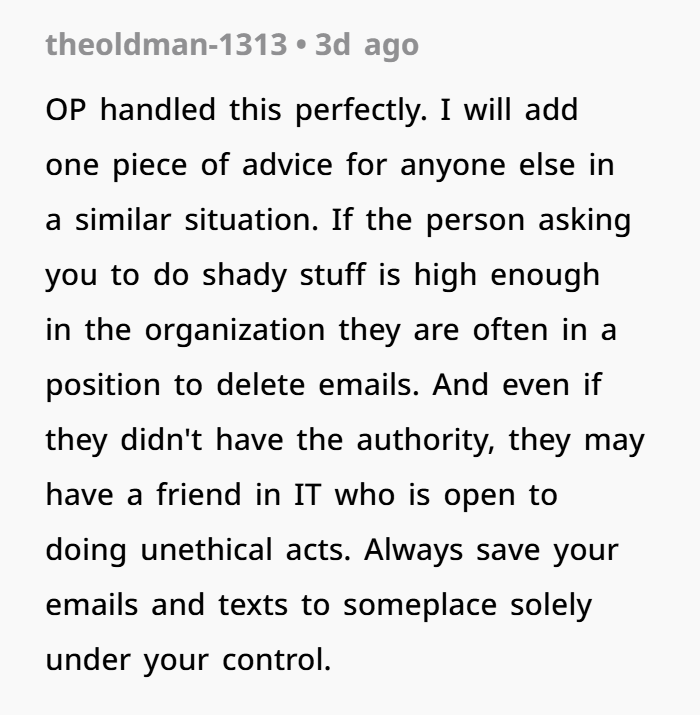
Advertisement – Continue Reading Below
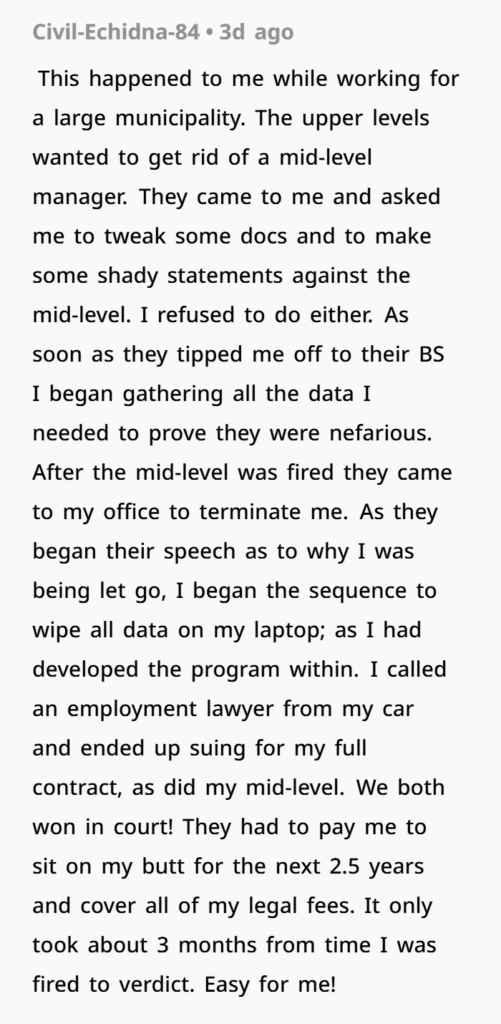
Advertisement – Continue Reading Below
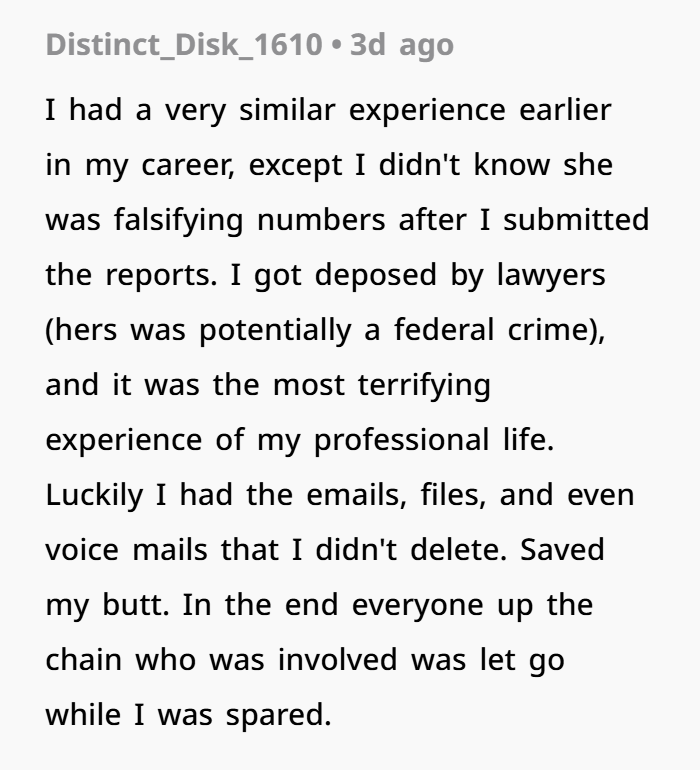
Advertisement – Continue Reading Below
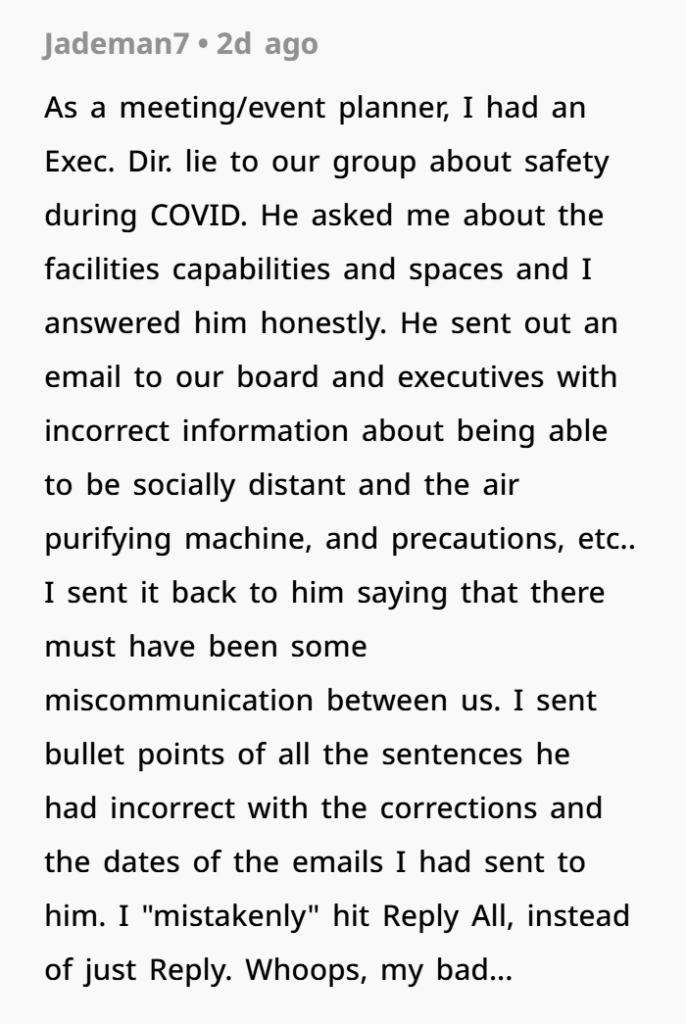
Advertisement – Continue Reading Below
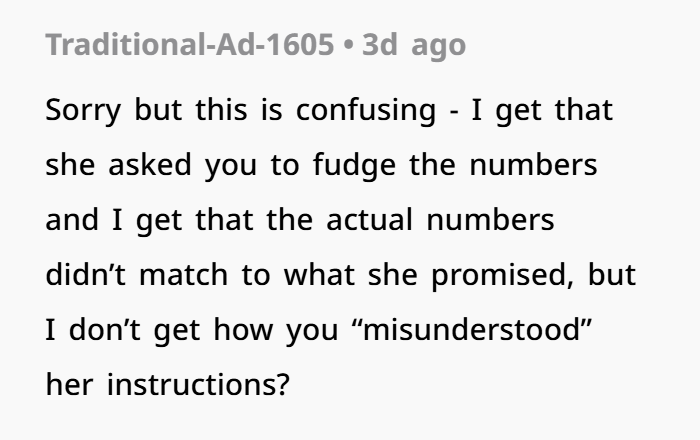
Advertisement – Continue Reading Below






